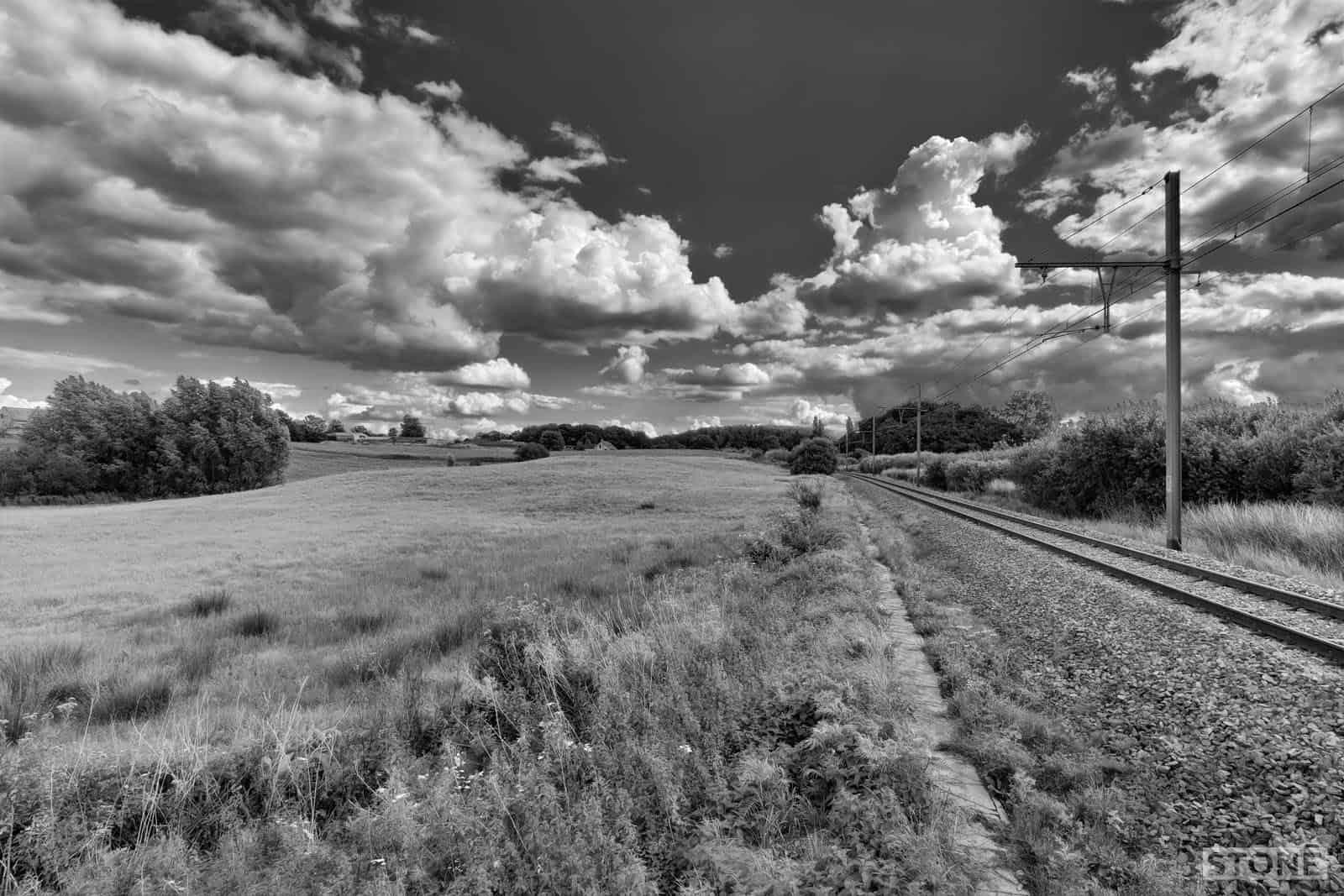It looks like a field, because it is a field, one that slopes gently up to a low ridge, 60 metres at its highest point, best appreciated either from a mile or so back in the open areas behind the old line. It looks like nothing much, close up it is just a slope and gentle stroll across quite long grass that will prick the skin and raise the heart rate slightly. The land is bumpy but not unmanageable, too steep for a train to ride, which is why the three bumps you can see are higher than the ridge, these are partly composed of spoil from the cutting for the line in the 19th century joining Ieper to Lille, the track passing through the ridge,
As you leave Ypres on the South side and Head towards Zwarteleen by car you cross the track twice, to get to this little field you park against a farm and cross the road, walk down a track where you cross it again on foot. Orange lights and barriers on an partially metalled farm track. The single line curves like a reversed S, carrying it through the fields and on into the cut. The tracks pass a curious little cemetery; this is Larch Wood Railway Cutting, named after a small copse of larch that sat here on the side of the track, a few still grow, ancestors or more likely deliberately planted to maintain the history, carry the line through time. The barriers close, lights turn red and a bell beats you out of any possible reverie in the field edge. The trains blast past sucking the air.

The cemetery is a curious one, an entrance way stands next to the crossing, the farm track curves off in the one direction, on the other side the statement of standard empirically laid CWGC brick and Portland stone, manicured grass and clean trimmed edging onto a field that yields rusty orange lumps of shrapnel. The finger of grass runs for fifty feet to the actual plot, itself cut off from by a low wall from a field of potatoes, this corner of a foreign field another immaculate remnant of dusty empire an older Britain. The usual rows of white stone peel off in staggered rows. Two rows of special memorials ‘known to be buried here’ run down two of the walls evidence of confusion and turmoil in the ground.
The central rows of stones sit like uneven teeth the skeletal broken smile of unplanned battlefield death and interment. In here lies ‘Uncle Clarence’; Clarence Peel, a King’s Royal Rifles boy bought back into the light by Alan Bennett the writer and playwrite, who searched, found and visited him here, then drew the story of a Leeds boy, an only son, his life, their life after he’d gone, just a grey photograph and some medals, pieces of paper and awkward memories of family lives wrapped around his grandmothers tears still there years later, shed about her ‘grand fellow’. He’s lain here since October 1917, then aged 20, his company, those who visit and the 855 men and boys who are also buried here, 321 of whom don’t have the luxury of a name.
The cemetery itself is long and narrow, widening at the end, the Cross of Sacrifice and memorial stone sit sideways across it’s width and beyond at the end lies a low wall separating the clean trimmed grass from the unruly mop and clump of loose pasture. Modern barbed wire hangs loosely between ancient rusted silent screw pickets another echo of the past above the surface of the land. Beyond these the field rises, its surface contorted into a swirl; a sign of turmult under the green carpet a memory of what is buried beneath. Within the act of willful trespass the wire pings and pinks behind a long step forward from this spiritual no-mans land into an almost silent field the only sound the rustling of the maize and dull hum of cars and life in the distance.
Those contortions in the land are the head of the Berlin Sap, so called because it was so long they said they might reach Berlin. It is a massive feat of engineering, not alone on this piece of front, from here burrows stretch built deep into the clay, two drives, one heading out under Hill 60 on the left, the other veering off to the Caterpillar on the right, so called because of its wriggling shape. There is alleged to be second even less visible entrance here in the field now lost in the edge of the embankment.
From this position in August 1915 the 175th Tunnelling Company Royal engineers began to dig a gallery 600 feet behind the British line over 90 feet down into the stable clay layers. In April 1916 The 3rd Canadian Tunnelling Company took over and completed it. No mean feat when you look at the houses like tiny blocks at the foot of the ridge. In The July of 1916 the Hill 60 mine chamber was charged with 53,300lbs of gun cotton and ammonal. Caterpillar was filled with a 70,000lbs in October. The 1st Australian Tunnelling Company took over in November led by Captain Oliver Woodward. They maintained the mines over the winter. Policing the warren against countermining checking wires, trying to keep the charge dry and listening to the walls hoping not to hear a scrape or the thud of a subterranean raiding party, just them and their explosive hoard buried in this cool wet dripping hole until 3:10 in the morning of the 7th of June 1917, when these two mines and seventeen others were fired, heralding the start of the Battle of Messines. And the tunnels, presumably something still remains, certainly entry was possible for a good few years after the war ended for foolhardy explorers, and now there will still be hollows and cavities, water and remains
No photos or footage exist of the blasts, but standing in a field looking at the low tree covered ridge over the mine entrance, and knowing how big the craters that remain along the front it is just about possible to imagine the massive plumes of earth rising into the night sky. And behind this spot in the field, among the larches is the balance translated into British and Commonwealth graves, while in front as many as 10,000 German lads ceased to exist, many still lying in those quiet hills.

